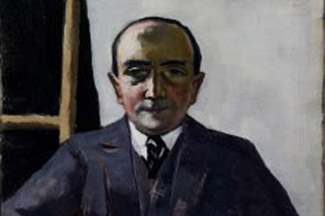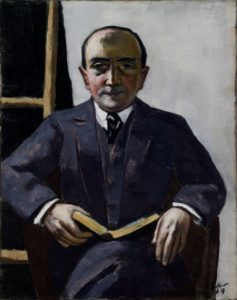
The Collector Curt Glaser / Castaway Modernism by Robert J. Parsons
This is a major art event – and then some.
Indeed, the two hefty catalogs (238 pages for Curt Glaser and 288 pages for Modernism) bear witness to an undertaking that goes far beyond ordinary museum exhibition practice and takes us deeply and in detail into one of the most fascinating – and dark – periods in the history of what we like to call Western civilization.
“History” is the key word here, for, far more than most major art shows, this assemblage of art work requires an awareness of the times that produced them – and tried to obliterate them.
Accordingly, it is double, two exhibitions, distinct yet inextricably entwined by their historical context.
Curt Glaser’s collection, dispersed already in his lifetime and reassembled here to a considerable extent (an exploit in itself), chronicles the evolution of artistic activity before and after the first World War and the taste of the collectors whose purchases largely supported that activity. And, as always, this activity and the taste manifested in supporting it tells us much about the world where it was produced and celebrated then denigrated and cast aside and even destroyed outright.
By this point, art had long been accepted as having other vocations than moralizing, inspiring virtue and keeping the unwashed out of pictorial representation. Nothing was considered an unworthy subject, no matter how prosaic, no matter how shocking – nor distorted, by traditional representational standards. This, the new Nazi government declared to be “degenerate” and even downright subversive, and in 1937 they set about purging the country’s fabulous public collections of it.
Glaser, born in 1879, was a Jewish German art historian and collector, and as director of the Berlin Art Library, a central figure in the Berlin arts scene in the decades 1910 and 1920. He and his wife Elsa assembled a major collection which they exhibited in their huge Berlin apartment.
In 1932 Elsa died and in April of the next year, following the Nazi’s accession to power, Curt was removed from his post. Realizing that the new government comprised not only strongly anti-Jewish elements among its most powerful members but people who were art illiterate, he was quick to see how the wind was turning. Accordingly, he auctioned off his collection in Berlin that year and moved to Switzerland then on to New York, where he died in 1943.
At this fabulous 1933 auction, the Kunstmuseum Basel acquired some 200 drawings and prints, including works by Edvard Munch. In 2017, Glaser’s heirs demanded the restitution of the works, pointing out that they had been sold off under great pressure and entirely against Glaser’s wishes. As part of the settlement, the exhibition pays tribute to Glaser and his outstanding commitment to artists such as Max Beckamnn, Ernst Ludwig Kirchenr, Henri Natisse and Edvard Munch, all in the vanguard of the evolution of pictorial representation in the Western world.
The exhibit boasts the distinction of being the first time that works from Glaser’s great collection – which are now scattered throughout the world – have been reunited.
The concurrent exhibition, Castaway Modernism (whose original German title, Zerrissene Moderne is better translated by the French title, La modernité déchirée) focuses on the following years and the determined effort of the Nazis to obliterate what they declared to be testimony to the wild decadence that they purported to correct – in short, exactly the art that Glaser had devoted his life to collecting, preserving and promoting.
While Glaser’s experience represents a single, early example – precursor – of the sea change overtaking the German art world, Castaway Modernism provides a detailed look at the subsequent social, political and economic forces at work building a new Germany where such art was seen as indisputably immoral. Much more than a dramatic change in taste and official favor, “degenerate” and what it was applied to reflects the straight-jacketed Nazi mentality that was to dominate Germany, then a great deal of continental Europe, until the end of the war.
As the Nazis steadily secured their hold on Germany and its institutions, high National Socialist morals and standards in taste came ever more into play. By 1937, it was determined that the country’s splendid public museums had to be purged of such corrupting trash, and hundreds of great art works were confiscated and assembled in a major exhibit in Munich (in the Nazi heartland) to demonstrate to the public what corrosive influences – in particular the Expressionists – National Socialism was saving them from. Thus was born the exhibition Degenerate Art.
From Munich, Degenerate Art went to Berlin in 1938, with some major alterations that demonstrated that even among the die-hard Nazi arbiters of fine art there were significant differences of opinion as to what was degenerate. Since there had been considerable public outcry in Munich over the denunciation of artists such as Munch and Mondrian, these lost their degenerate status, but they were replaced by others. The common thread throughout all this eventually became the catch-all designation “Jewish-Boshevist”, never defined hence eminently useful.
The exhibit then traveled to Leipzig, Düsseldorf, Salzburg and Hamburg, undergoing another major reorientation in Salzburg. It continued to travel and to be modified well into the war years.
However, over time, there was a filtering out of almost everything considered “salable”, replaced by regional and little known artists. By 1939, there were major auctions under way, and that is where the Kunstmuseum Basel comes on the scene.
The current main museum building was opened in 1936 after decades of cramped and inadequate space for its already great collection whose most recent works were from the impressionists, by then accepted as worthy of space. The challenge then was not just to fill up the vast new space available but to draw the collection firmly into the twentieth century. Otto Fischer, the director at the time, remarked,” Our moderns do not fill even the grand foyer. Everything else is blank canvases on which we paint a bright future.”
On 1 March 1939, he was succeeded by Georg Schmidt, who resolutely pursued the acquisition of the works of which Germany was being divested. As a first move, in June of the same year, at the auction of “Paintings and Sculptures of Modern Masters for German Museums” organized by the Galerie Fischer in Lucerne, he bought twenty-one works of German European modernism. The purchases continued apace. In the end, the Kunstmuseum Basel purchased more objects from the works confiscated from the German museums than any other institution.
Most of these works were considered at the time by the museum’s trustees (whose responsibilities included supervision of acquisitions) as of secondary interest. But they were to gain in importance over the succeeding decades to become esteemed as one of the greatest collections of its kind in the world.
In the current exhibition, they are displayed in their historical context, side by side with other major works from public and private collections all over the world as well as alongside works from the auctions that the Kunstmuseum Basel wished to purchase but could not owing to budgetary restraints. There is also a section devoted to the fate of works that feature in the history of the Basel acquisitions yet are now considered destroyed or missing.
These works represent what art historians have called the “forgotten generation”, artists too young to have made a major mark in the art world and whose careers were cut short by their being designated degenerate if not downright subversive.
The lengthy press release closes with an interesting anecdote in this regard.
“Marg Moll’s Danser is an especially striking illustration of the vagaries of the history of loss bound up with the persecution “degenerative art”: until recently, the work, which was displayed in the exhibition Degenerate Art, was thought to have been destroyed. In 2010, it was recovered during the construction of a new subway line from the rubble left by the bombing of Berlin.”
The Collector Curt Glaser: from Champion of Modernism to Refugee (Der Sammler Curt Glaser: Vom Verfecter der Moderne rum Verfolgten) runs through 12 February 2023.
Castaway Modernism: Basel’s Acquisitions of “Degenerative Art” (Zerrissinen Moderne: Die Basler Ankäufe “entarteter” Kunst) runs through 19 February 2023.
Photo credit: Bildnis Curt Glaser Copyright Kunstmuseum Basel






